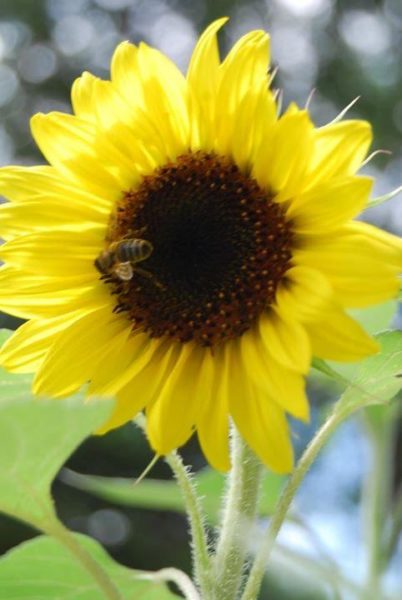
Kathleen Miller
Gaia’s Farm and Gardens
Sustainable living, gardening, and farming is based on an understanding of ecosystems, the study of relationships between organisms and their environment. It has been defined as an integrated system of plant and animal production practices that will last over time. Having a harmonious relationship with Gaia (Mother Earth) provides food for people, enhances the natural environment upon which the community depends, makes efficient use of resources and integrates natural cycles that sustain economic viability as well as enhances the quality of life for the community as a whole.
Few sustainable farm enterprises yield so much satisfaction in return for such a small investment in money and labor as beekeeping. Once the bees are established, a single hive can easily produce 30 pounds or more of delicious honey each year. That is enough to supply the needs of the average family plus leave you with plenty to give away or sell. In return, bees need only minimal attention and a little feeding to carry them through the winter. Bees gather food from a variety of plants. Wildflowers, fruit blossoms, shrubs, trees, and even weeds are sources of nectar that bees convert to honey and of the pollen that supplies their vital protein needs. Bees also perform the service of pollination of many plants. They are very efficient and commercial fruit growers often import bees to pollinate their orchards.

Beekeeping dates back to the early colonial period when British settlers first brought honeybees to America. Some swarms escaped and established themselves in the wild; these free-spirited bees spread themselves slowly westward to the edge of the Great Plains, where the lack of hollow trees for nesting stopped them. It was not until the 19th century that bees reached the far West, carried there in the wagons of settlers and homesteaders. In colonial times, bees were kept in hives of straw, called skeps, or in hollow logs. Lacking scientific knowledge, beekeepers often found their hives wiped out by disease. Honey yields were often low. Thanks to scientific advances since the 1850’s beekeeping have come a long way.
The right location for your hives will get your bee colony off to a good start and help ensure a productive future. One of the first things to look for a site is good drainage. Dampness leads to disease and encourages the growth of mold. Ideally, the hive should be set on a gentle slope so rain and melting snow can drain off. Avoid low spots where water can collect. Raising the hive above the ground on bricks, cinder blocks, or other supports helps to combat dampness. The site should be sheltered from the wind. Bees are susceptible to cold, and even a mild breeze can chill them enough to reduce their efficiency. Severe cold can kill bees, and in winter a good windbreak may mean the difference between survival and death for an entire colony of honeybees. Another important factor is adequate sunlight to warm the hive. To maintain the hive’s normal inside temperature of 93 degrees, bees must burn honey, thereby reducing the yield. Experienced beekeepers orient the hive entrance toward the east or south to take advantage of the warming effect of the morning sun. Afternoon shade is also important, especially in the hotter parts of the country, since excessive heat can be as deadly to bees as excessive cold.
Be sure there is a good supply of forage plants as sources of nectar and pollen before setting up a hive. Since bees can easily forage as far as two miles from the hive, this is seldom a problem since excessive heat can be as deadly to bees and excessive cold. Start your colony in early spring so the bees can build up their numbers before the honey flow begins. Start on a small scale with one or two hives. Two hives have an advantage since if one queen dies, the colonies can be combined. Of the various strains available, Italian bees are the best for beginners. They are gentle, good foragers, and disease resistant. Caucasian, Carniolan, and Midnite bees, also popular, tend to swarm and stray. Mail order bee houses and bee supply specialists offer complete beginners’ kits, including bees, hive, tool, protective gloves and veil, and instructions. As the season progresses, you can purchase extra supers and frames. Bees need plenty of freshwaters. A nearby stream or pond, a pan of water with a wooden float for the bees, or a slowly dripping hose with supply them.
Bees are shipped in packages with wire-screen sides, usually containing a mated queen, 2 1/2 pounds of bees and a can of syrup to feed them en route. The queen is in a small cage inside the package with several workers to tend her. The exit hole of the queen cage is usually closed with a plug of soft candy that the other bees will gnaw through to release her. Check your bees on arrival to make sure that they are healthy and that the queen is alive. Bees sting only when the feel threatened. It is important to wear protective gear. A hat and veil are basic, coveralls, gloves, and boots are recommended. Move slowly and gently-sudden or abrupt motions alarm bees. To open the hive, quiet the bees first with your smoker.
Gaia’s Grow Tips-Bee Blossoms
Alfalfa
Aster
Black-Eyed Susans
Clover
Dandelion
Goldenrod
Orange and other citrus
Sage
Lilac
Lavender
Wisteria
Mint
Sunflowers
Honey Suckle
Poppies
Lantana
Snapdragons
Sedum
Purple Coneflower
Support Northern Colorado Journalism
Show your support for North Forty News by helping us produce more content. It's a kind and simple gesture that will help us continue to bring more content to you.
BONUS - Donors get a link in their receipt to sign up for our once-per-week instant text messaging alert. Get your e-copy of North Forty News the moment it is released!
Click to Donate
